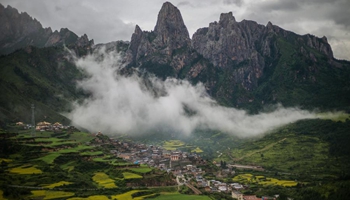LHASA, June 23 (Xinhua) -- Tuotuohe River Station maybe small but it is an important stop along the Qinghai-Tibet railway, the world's highest altitude train line, which links the Tibetan capital Lhasa in southwest China and Xining, capital of Qinghai in the northwest.
Tuotuohe is about 4,000 meters above sea level in Qinghai Province. After Tuotuohe, the trains climb even higher along Kunlun Mountain. It is the last stop for many tourists on their way to Tibet. Medical workers are on standby at the station to treat those who fall ill.
"All kinds of people come by train and many insist on continuing with their journey if they fall with altitude sickness," said Phurdo Tashi, 40, who sells food near the station.
Many people get off the train at Tuotuohe, to try and catch a glimpse of the rare plateau animals like the Tibetan gazelle, and to take in the unparalleled beauty of the source of the Yangtze River.
"During the summer season, all the carriages are full to bursting. The number of people on one day is more than we saw over six months just a few years ago," said Tashi.
The 1,956-kilometer railway, which at its highest point is 5,072 meters above sea level, turns 10 on July 1. Over the last decade, it has helped tourism boom along the rail link.
"Riding on the trains, the highest in the world, is a rare experience," said Wang Songping, deputy director of Tibet tourism department.
"The train has made many unseen areas such as Yarlung Zangbo River Grand Canyon and Mount Qomolangma accessible to visitors," he said.
In 2015, 20.2 million holiday makers visited Tibet, 11 times more than before the railway started service. Moreover, tourism spending last year exceeded 28 billion yuan (about 4.3 billion U.S. dollars), 15 times more than a decade ago. More than 100,000 people in Tibet ware working in tourism, with per capita earning of more than 10,000 yuan every year.
All the 329 families in Namtso Village, which is in a national park in Tibet, work in tourism. They are tour guides, restaurant owners and handicrafts sellers. Families can earn up to 500,000 yuan a year, said village chief Tashi.
Phalha Mansion, in Tibet's Xigaze Prefecture, is one of 12 aristocrat mansions in old Tibet. Most of the people in the nearby Paljor Lonpo village are descendants of serfs who used to work for the Phalha family.
Phurbu Cering, 32, works as a guide for visitors to the mansion. "The number of visitors has grown every year, both from domestic and overseas," he said. Cering takes home at least 4,000 yuan every month.
Dai Jingbin, an official from Shanghai, is on the Tibet development team. His team spent more than 68 million yuan on repairing and expanding Sakya Monastery in Xigaze Prefecture. "People now stay longer at Sakya town and the monastery," Dai said.
"Tourism is a green economy that could generate revenue for the local government, boost employment and increase people's income, without doing much damage to the environment," he said..
Gelsang Tashi is a teacher who lives along the railway. "I often see people holding prayer wheels and chanting as trains pass. The train has increased their connection with the world, brought opportunities, and prosperity," he said.










